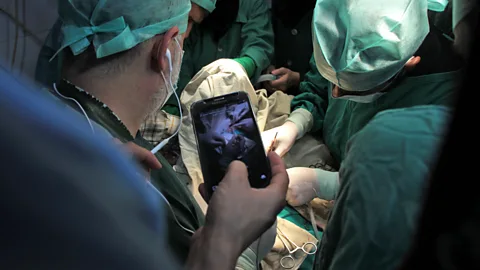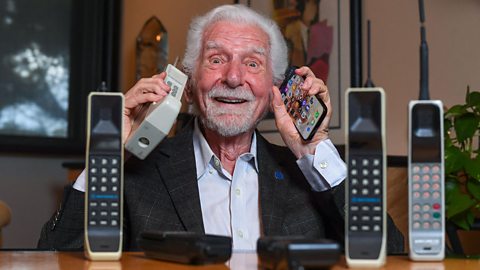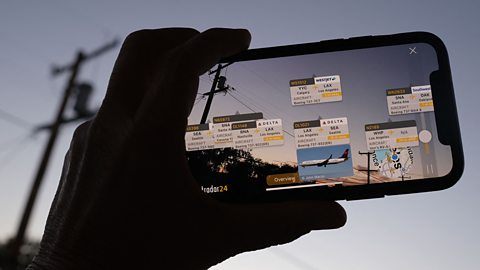The surprising ways cellphones have changed our lives
 Getty Images
Getty ImagesThe first ever call made with a mobile phone was a conversation 50 years ago between two rivals developing cellphone technology. Since then, the devices have found some unexpected uses.
The year was 1973. Joel Engel, an American engineer who had worked on Nasa's Apollo programme, was leading an effort to create the world's first handheld mobile phone. Research at Bell Labs, where Engel worked, had several decades earlier contributed to the development of clunky, car-phones that allowed calls to be made on the move. His team were now trying to take the technology a step further – a device that could be carried around everywhere.
On 3 April, however, the landline in Engel's laboratory rang. He picked up.
"Hi, Joel," said the voice at the other end of the line. It was Martin 'Marty' Cooper, the leader of a rival research group at a radio and electronics company called Motorola.
"I'm calling you on a cellphone, but a real cellphone," Cooper said. "A personal, handheld, portable cellphone."
The race was won, and in some style. Standing in front of reporters and photographers, Cooper had made the call from in front of the Hilton Midtown hotel on New York's Sixth Avenue – around 30 miles (48km) from Bell Labs in New Jersey where Engel stood silently on the other end. Soon it would be possible to hold conversations with another person – and even multiple people at once – from anywhere at any time. The ability to beam short text messages, and later pictures and eventually emojis, would then follow. But while mobile phones transformed the way our species communicates with one another, it barely scratches the surface of what they have enabled.
Fifty years after that seminal call by Cooper, mobile phones are now extraordinarily multi-functional. And they have changed our lives profoundly – sometimes in unexpected ways.
Cooper's prototype phone was brick-shaped and beige, with a large antenna and no screen. It was not an elegant device, but it had facilitated a landmark moment. Cooper's triumphant call to Engel was the first handheld mobile phone call.
Though the US government was supportive of the project, there were many technical and regulatory challenges. It took another 10 years for the device to become available to consumers. But the era of the mobile phone had begun – and it is an era in which the devices have profoundly changed our lives.
 Getty Images
Getty ImagesThe first iterations were expensive and cumbersome. Leslie Haddon, a lecturer in media and technology at the London School of Economics, was an early adopter, paying £300 (roughly $500 at the time) in the late 1980s for a Motorola.
"I could get my fingers round it," says Haddon. "It wasn't a brick at that stage, but it was a half-brick. It was substantial. You wouldn't put it in your pocket very easily."
At that stage, the function of mobile phones was to stand in for landlines, says Christopher Windmill, a senior lecturer in computer science at the University of Derby. "We'd just cut the cord," says Windmill, "We'd got access to voice communication and very little else on those very early devices in the 1970s and 80s."
Those humble beginnings were soon forgotten. The Nokia N95, released in 2006, had an FM radio, a colour screen, stereo speakers and a video camera. It also had very slow internet access. For a few months, it was the best phone on the market. Unfortunately for Nokia, the following June saw Apple's demonstration of something called the iPhone. Here in the 2020s, iPhones are ubiquitous worldwide, and an "N95" is a type of face mask.
But the N95, like the iPhone, exemplified the key quality that differentiates modern mobile devices from their predecessors – they are not simply phones, but instead combine a wide array of technology. Computer chips and transistors, says Windmill, have become smaller and faster, allowing the functionality of the devices that contain them to expand. "We get more processing power on them, and more ability to put sensors into them," he says.
Hence the early smartphones' inclusion of internet browsers, cameras, location services, torches, Bluetooth and accelerometers – circuitry that can tell what angle a phone is held at, allowing the device to automatically switch your display from portrait mode to landscape. This technological bundling has been intensifying ever since.
Today's smartphones are banking hubs, personal assistants, pocket-sized cinema screens and music players. They incorporate gyroscopes, barometers, thermometers, magnetometers, infra-red sensors and fingerprint sensors.
Mobile internet speeds have radically improved, thanks in part to the rolling-out of services such as 5G internet (and manufacturers are already discussing the prospect of 6G networks in the coming years). The computational power packed into phones has also increased, and innovative software applications have opened up innovative ways of using these devices.
Take medicine. In brain surgery, iPhones have already begun to replace the expensive equipment that display the videos captured by endoscopes. During the Covid-19 pandemic, Bluetooth enabled software engineers to build contact tracing systems that could tell when we had been in close proximity to infected individuals – delivering us the dreaded "ping". Video calling allows medics to communicate with, and provide diagnoses to, patients in remote areas.
Combining artificial intelligence with the extraordinary data-gathering capabilities of smartphones, is creating other opportunities. One British start-up, Novoic, uses machine learning to detect early signs of Alzheimer's Disease by analysing speech recorded on mobile phones.
You might also like to read:
Similarly, GPS equipment in phones allow us to use them as sat-navs. But bundled technology has also enabled the creation of navigational features that are less well-known than Google Maps, but highly valued to their users – such those that facilitate haptic, or touch-based, navigation for the blind.
Researchers have used the vibration capabilities within most modern smartphones to create the digital equivalent of tactile maps that people with visual impairments can use to feel their way around their environment. By varying the intensity and frequency of the vibrations, they can even create the sensation of different "textures" on the screen as the user feels their way along a route, giving an indication of features or landmarks they might want to be aware of. One phone app, HapticNav, has gone a step further by linking to a wristband that guides people to their destinations using vibrations.
In school classrooms, however, mobile phones have often been far less welcome, serving as a distraction to students. But they can also be vessels for interactive learning. Apps such as Duolingo have gamified language learning while others such as the Complete Anatomy app, have brought a powerful new way for medical students to learn about the intricate workings of the human body with a few pinches and swipes. "You can see how muscles move," says Windmill. "You can dismantle bones and see what they're actually made of."
Apps like these are helping to democratise education, he adds. "You don't need an expensive PC. You don't need expensive headsets. You can have augmented reality, or virtual reality, on any device."
For younger children, Windmill points to an augmented-reality animation app created by researchers at Disney, which brings drawings of cartoon characters to life on a phone screen as they are coloured in.
 Getty Images
Getty ImagesThere are few arenas of human endeavour left untouched by the smartphone. Phones have come to mediate even our engagement with the natural world. Many of us use apps such as PictureThis, or Google Lens, to identify plants we encounter, but farmers are also able to use phone-based apps to help them identify weeds, disease, pests and the signs of stress in their fields.
Farmers are also making increased use of phone-based tools that help them manage their irrigation schedules, drawing on data from local weather stations. And scientists can monitor a forest's carbon sequestration, and general health, via data collected by LiDAR scanners that now come built into many leading phones including recent iPhones. LiDAR stands for "Light Detection and Ranging", and uses a pulsed laser to measure distance to quickly build up a 3D digital model of an object or a room. It is what enables the IKEA Place app, for instance, to show you what a given piece of furniture would look like in your house. Researchers at the University of Cambridge have found a way of using these phone sensors to measure the diameter of trees in woodland, allowing them to estimate forest health.
But phones bring challenges as well as benefits. They have led to widespread fears about the ill-effects of smartphone "addiction" and the ready access they give to social media such as Instagram and Twitter. But evidence for how mobile phones affect the mental health of children, for example, is inconsistent. (Read more about if there is a right age to get a smartphone.)
As smartphones continue to evolve, however, so too will the capabilities they unlock.
The identical-looking rectangular slabs most phones have become – the "candy bar" shape, as manufacturers put it – could give way once more with a new generation of folding phones, and the capacity for much larger screens that fit inside our pockets, says Elizabeth Woyke, author of The Smartphone: Anatomy of an Industry.
The same goes for smart glasses, Woyke thinks – a change that would mark the transference of smartphone capabilities to wearable technology. Google Glass was a high-profile failure, says Woyke, "but there is actually a lot of logic to smart glasses once they can figure out how to make a good pair".
Why rummage in your pocket for a device when audio can be piped directly to your ears and images can overlay your vision to help you navigate, shop and even recognise people.
Who would have thought that Engel's beige box would create such a spectacle?
--
